How community solar works
Community Solar: Part 1
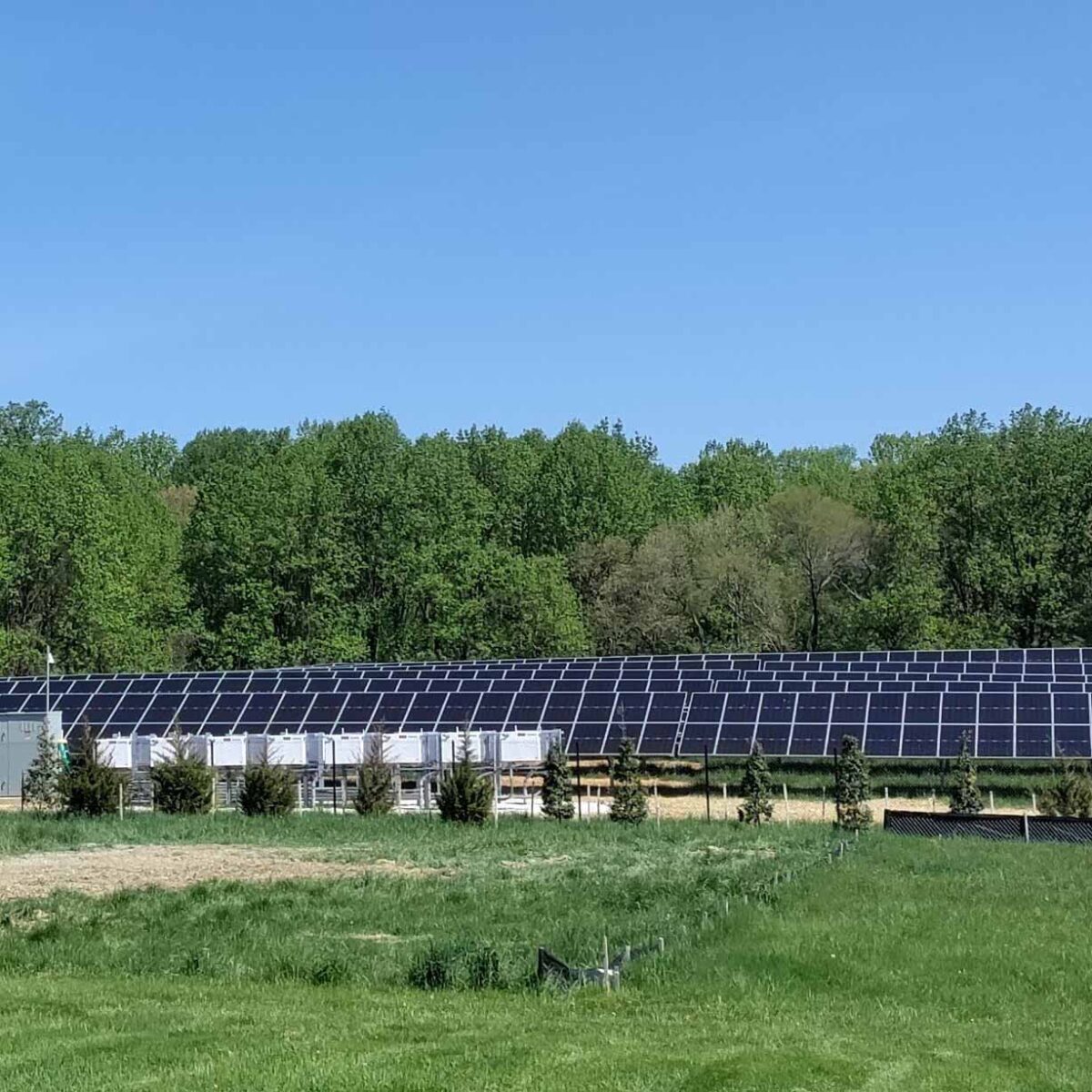
Community solar: no roof, no problem
Are you one of the millions of Americans who can’t put solar panels on your roof? We have good news: you can still benefit from solar energy—with community solar!
Community solar, sometimes called “shared solar,” makes it possible for everyone to save with solar. That includes condo and apartment dwellers, renters, and homeowners who can’t—or don’t want to—install solar on their roofs.
Wait, so where do the panels go if not on your roof? Out in your community! The solar arrays are located somewhere in your area, like a field, building, or parking lot.
Here’s how it works:
You sign up to participate in a community solar project in your community. Then, you get to enjoy the benefits and savings from your share of the electricity they produce! The cost is often less than what you’d pay your utility company.
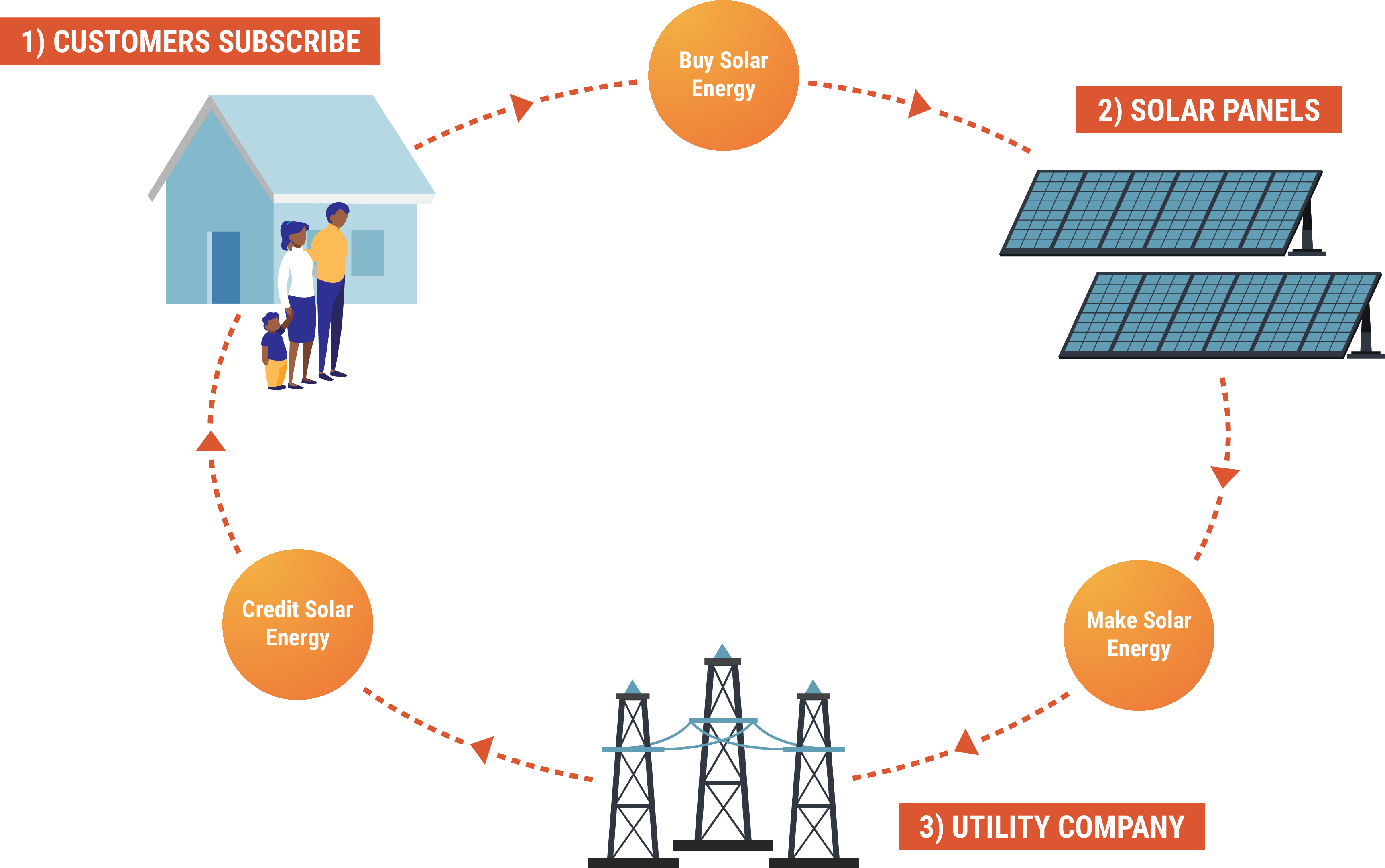
The three steps of community solar
1. Customers subscribe to community solar
You subscribe to a community solar project and pay (usually monthly) to participate.
2. Solar panels produce energy
The solar panels, located somewhere else in your utility area, produce clean energy. It goes directly to the electrical grid.
3. Utility company sends it to customers
The utility sends electricity to customers. Community solar subscribers receive credits on your electric bills for their share of the community solar.
The main players in community solar
Utility
The electric company delivers electricity to customer’s homes, including yours. The utility is also the one that applies your community solar credits to your monthly bill. The utility can be investor-owned, cooperative, or municipal.
Subscriber Organization
The subscriber organization operates the community solar array that you subscribe to. They support subscribers and report to the utility your share of the solar energy. This way, the utility knows how much to credit you.
The utility and the subscriber organization are usually different entities. In some cases, they are one in the same.
Customer or Subscriber
That’s you!
State differences
The rules for how community solar programs work vary by state and utility. Some states have different size limits, leading to various pricing for subscribers. Others may have differing rules on who is allowed to subscribe. In some states, you can subscribe if you’re in the same utility area or an adjacent one.
Each state makes its own rules for electricity service. But the basics of community solar remain the same: install solar panels in the community and allow people to participate in getting credit for a share of the energy output.
The state-specific regulations on community solar change frequently as new legislation is passed. Below is a map of community solar projects and policies in the United States and its territories, showing which states currently have community solar projects or legislation, as well as states which indicate specific considerations for income qualified communities.

What is a community solar subscription?
Picture your community solar subscription as buying an item from your local family-owned hardware store instead of a national big box store. Your purchase from the community solar project is supporting jobs in your city. It helped pay for the solar company to install the panels as well as create other local jobs associated with or supporting the solar companies in the community. In addition, you know that solar is a wise choice for the future health of the planet. So being a part of a community solar project is good for everyone.
In most instances, a community solar subscription means you’re buying electricity from the community solar project instead of your utility company. You don’t own the solar panels, but you get a credit for the electricity they produce.
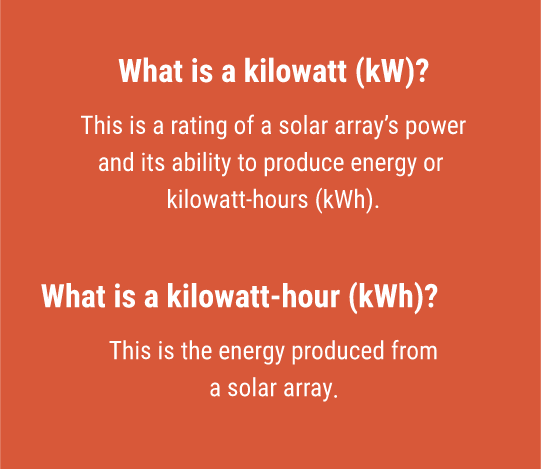
Kilowatt-hours explained
The community solar credit applied to your electric bill is measured in kilowatt-hours (kWh). This is the same measurement you see on your regular utility electric bill.
Although it’s less common, a community solar project might give you the option to buy a portion of the actual solar array. In that case, you’re buying all the electricity that your piece of the solar array produces. Depending on how many kilowatts (kW) you buy, you’ll get a certain number of kWh produced each month and applied to your electric bill as a credit.
How payment works for community solar
Unlike when a person installs panels on their home, community solar subscribers do not work with a solar company. Instead, they buy into a completed solar array out in their community.
Community solar subscribers pay a fee to the subscriber organization, the company that manages the community solar system’s subscriptions. This fee is paid either upfront or monthly.
The subscriber organization tells your utility company how much electricity your community solar share produces each month. That’s how the utility knows what to credit to your electric bill. It’s that simple and stress-free to save money each month with solar energy.
Community solar credit values vary by state and sometimes by utility company. Typically, it’s multiplied by the number of kilowatt-hours (kWh) your share of the community solar system generates.
In most cases, you’ll receive two bills each month: one from your utility and one from your community solar organization. But don’t worry: two bills are less than one!
With community solar, you should pay less than your current electric bill. This varies by provider and utility area, though. Talk to other subscribers. Speak to a local solar company to see what they know about the project. Do your homework.
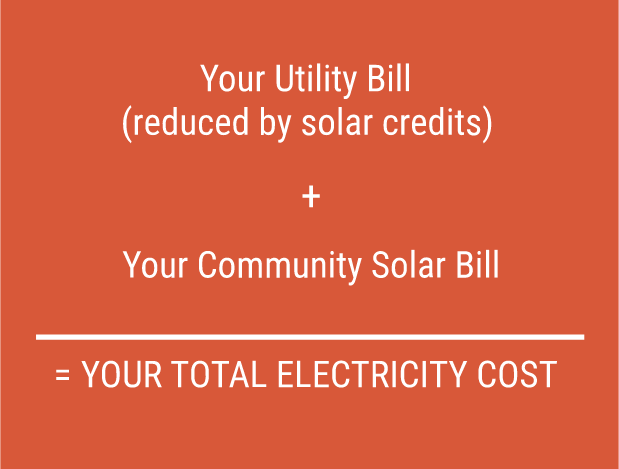
What your utility bill shows
Your utility bill will show a charge for utility electricity minus the credits from your community solar share. In most cases, you’ll receive a separate bill from your community solar provider.
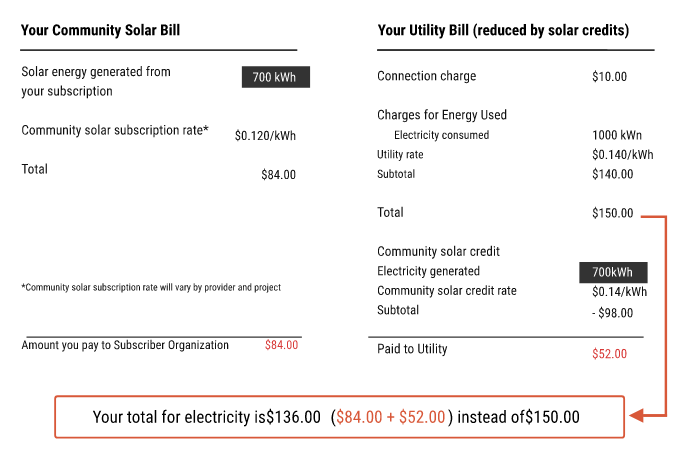
How much of your energy bill will come from solar
Your community solar provider should tell you how much of the energy you use will now be coming from solar. To find out how much electricity you use on a monthly or yearly basis, you can look at one of your recent utility bills.
Generally, you shouldn’t subscribe to a community solar share that is more than 100% of your total energy usage. Any energy you buy above 100% may get paid back to you at the end of the year by the energy company, but probably at a lower rate than what you originally paid for it.
Note that the rules around this vary by state and sometimes by utility.
What community solar isn’t
Occasionally, you’ll run into something that seems like community solar but isn’t. Here are some things community solar is not:
It’s not a group purchase for rooftop solar panels.
We love these group purchases! In fact, we facilitate them all over the country! We call them solar co-ops. Others call them solarize campaigns. But group purchases are very different from community solar, so don’t be confused. These groups bring neighbors together to leverage their collective buying power for competitive pricing on rooftop solar panels. Members of these groups each buy their own solar system and install the panels on their home.
It’s not retail supply.
Some states allow customers to pick an energy supplier other than the area’s utility company. Some of those suppliers offer “retail supply” or “green power,” which usually means hydroelectric, wind, or solar power. These offerings are often more expensive than what the utility charges. They’re often not local and can even be several states away.
It’s not crowdfunding.
Crowdfunding campaigns collect money in order to build a solar project. Community members donate money toward it, or make an investment in it. Crowdfunding participants may receive a return on their investment, but they don’t get any direct kWh credits for the electricity the project produces.
How community solar interacts with rooftop solar
Most community solar regulations and programs allow you to benefit from both rooftop solar and community solar. The specifics of this will vary by program.
Typically, you can subscribe to community solar to cover whatever electricity usage your rooftop solar doesn’t cover. This way, 100% of your energy needs can be met with locally produced solar energy.
Learn more about community solar
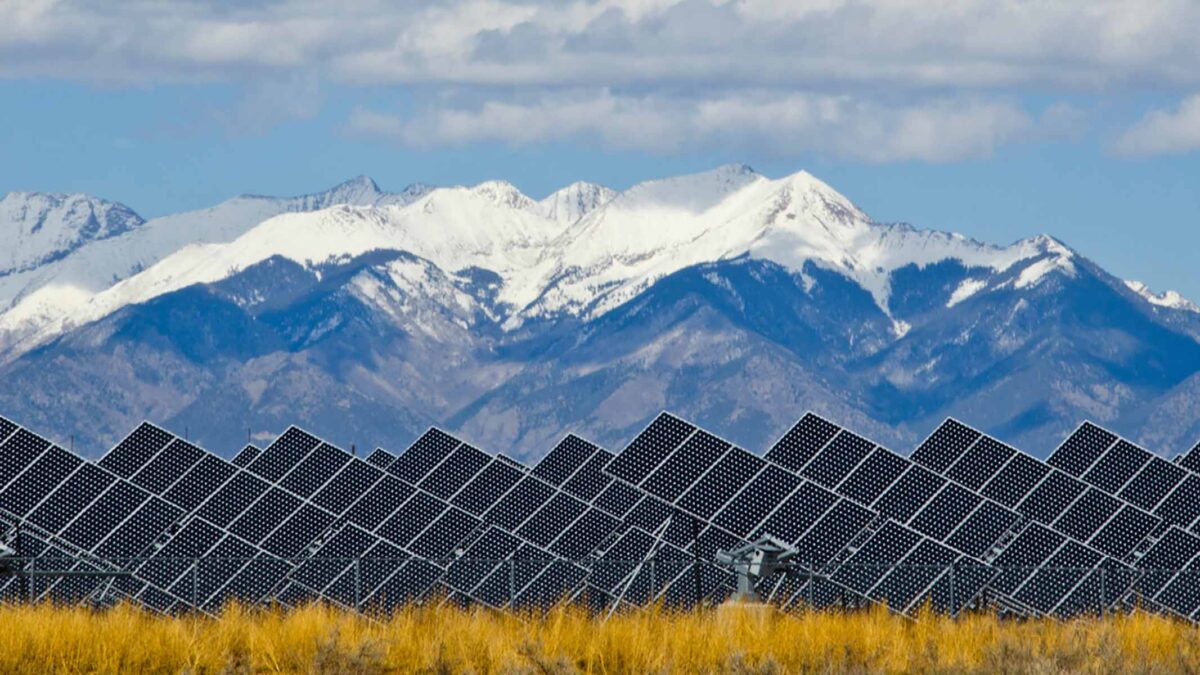
What to consider when shopping for community solar
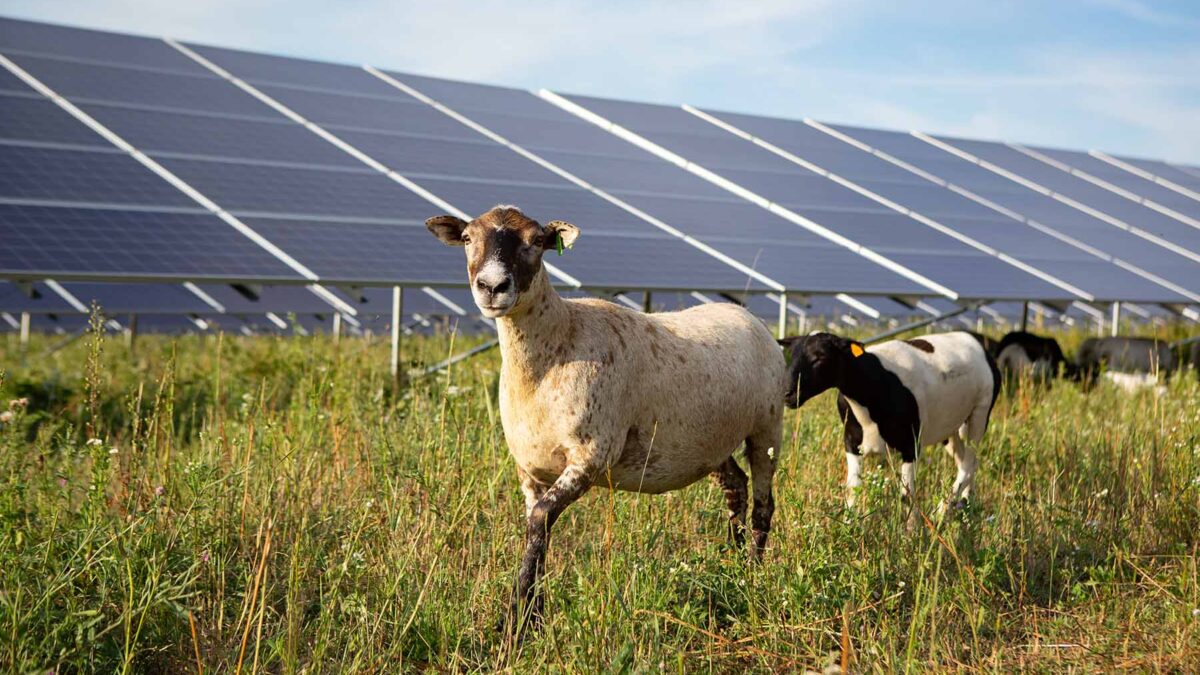
The community solar directory
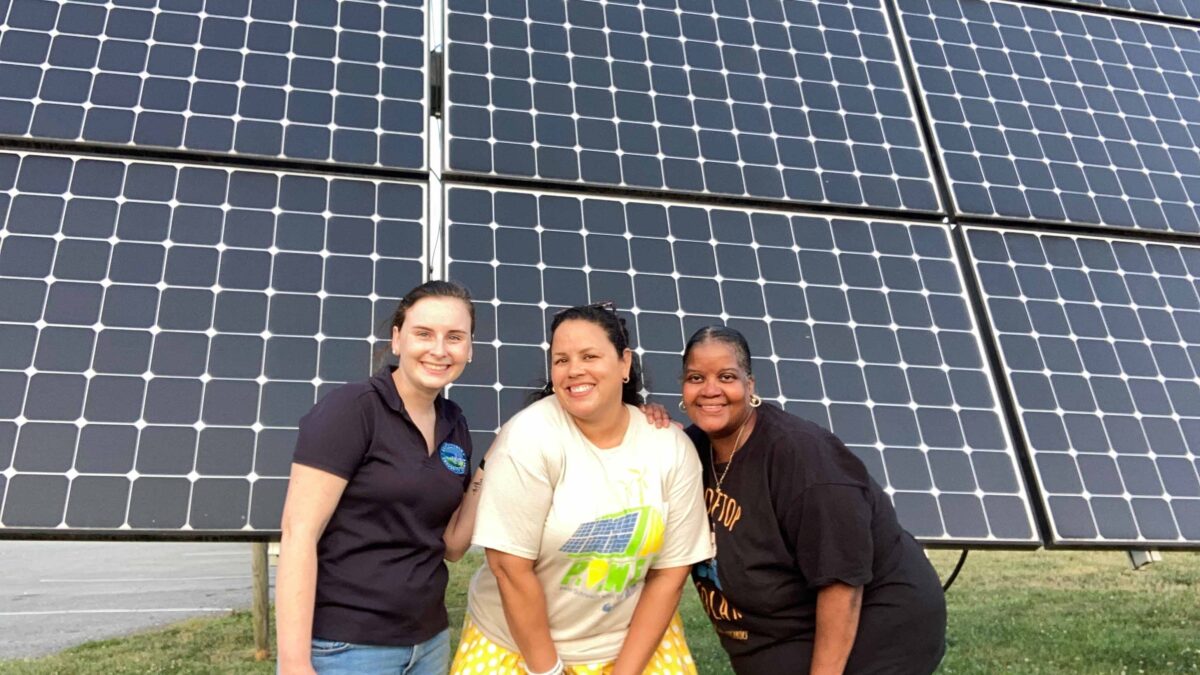
Advocate for community solar in your state
Consider these things when shopping for community
On our next page, you’ll find out what to look for to ensure you subscribe to the community solar project that’s best for you.
Get the latest on solar straight to your inbox.
Fight for your solar rights.
Everyone has the right to go solar. Spread the sunshine nationwide and in your local community by taking action, joining events, and more.